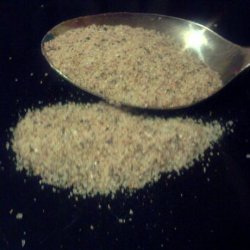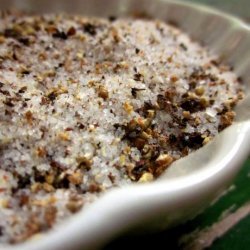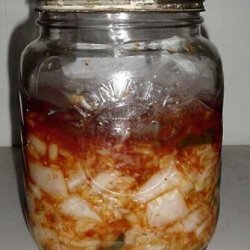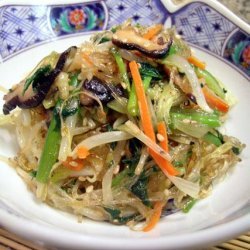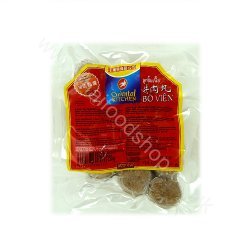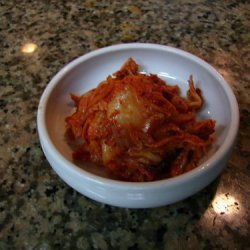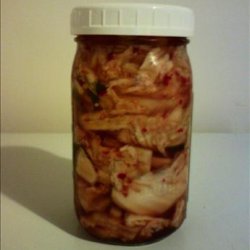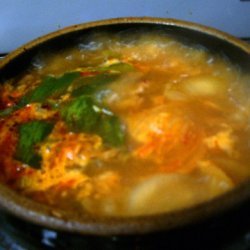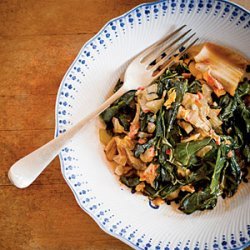Directions:
- Sang Mi’s classic kim chi recipe calls for two Chinese cabbages. (This is kind of a stupid name for a Korean recipe, but that’s what they’re called.) Rinse the cabbages, then quarter them lengthwise, discard the stems, and then chop the cabbages laterally, which should leave you with the largest pieces measuring perhaps 5 cm on a side. Don’t get too carried away while doing this.
- Now that we have lots of little bits of cabbage, it’s time to salt them. Place the cabbage in a clean plastic bag or equivalent (with no holes) and sprinkle salt over each layer. The best kind of salt is sea salt, although non-iodized table salt will do. This will create a brine solution with the cabbage juice.
- To ensure the cabbage is properly salted, sprinkle salt onto your wet hands, then rub it into the cabbage pieces. Press the leaves in your hand to squeeze as much water out of them as possible. Once finished, tie up the bag and set it aside for 5-6 hours. Check it after three hours to ensure that everything is all right, stirring the mixture if necessary.
- Take the cabbage out of the salt solution and rinse it if necessary. It should be a lot softer than it was. Again, remove surplus water. Place cabbage in a sealable plastic box. Add the spring onions, chopped into small pieces. Crush the garlic and ginger in a press and mix inches You may also add half an onion, finely diced, if you wish. You can also omit any of these ingredients (if, say, you’re allergic to garlic or hate ginger).
- It is also recommended to add kim chi sauce. This is the only ingredient that you can’t always buy at a non-Korean supermarket. (You might prefer not to know what’s in it.) There are several different kinds, many of which contain fish or other seafood such as oysters. You only need one tablespoonful — that’s 15 milliliters. This bottle contains 500 ml. Even for kim chi addicts, that’s a lot of kim chi. Kimchi will work without the sauce, but it helps things along.
- Add the chili powder. Unsurprisingly, the best chili powder for kim chi can be found at a Korean grocery store, which has a bright red color. It is possible to use other kinds of chili powder, or puréed or thinly sliced chili peppers if this is unavailable. If you use hot chili powder, you might want to reduce the amount. Add two tablespoonfuls of sugar.
- Mash the chili powder into the leaves as you did in much the same way with the salt. If the color doesn’t seem dark enough, add more chili powder. It’s a good idea to wear gloves while doing this. (Safety goggles optional.) Koreans use special kim chi gloves.
- This can be done as a cooperative effort. In fact, it’s a smart idea if you want to avoid carpal-tunnel syndrome. Squishing cabbage can be hard work.
- You can make kim chi from many other vegetables. This batch of kakk du gi is made of cubed white radish, prepared in the same way as cabbage kim chi.
- Put the containers aside for three or four days in a cool location. No snacking. After that, store it in the refrigerator.
- Finally the kim chi is ready. It should be soft in consistency, but not too mushy, with a little crunchiness left in the larger pieces. You can eat it as is, or use it in your favorite Korean recipes. If you don’t have a favorite Korean recipe, get one. Like I say, it makes a great stir fry. Someone wrote in to tell me he puts it on hamburgers.
Nutrition Facts
| Amount Per 1 Serving | |||
| Calories | 14.4 Kcal (60 kJ) | ||
| Calories from fat | 0.56 Kcal | ||
| % Daily Value* | |||
| Total Fat | 0.06g | 0% | |
|---|---|---|---|
| Sodium | 3239.04mg | 135% | |
| Potassium | 37.5mg | 1% | |
| Total Carbs | 3.25g | 1% | |
| Sugars | 1.83g | 7% | |
| Dietary Fiber | 0.42g | 2% | |
| Protein | 0.38g | 1% | |
| Vitamin C | 2.3mg | 4% | |
| Iron | 0.1mg | 1% | |
| Calcium | 11.8mg | 1% | |
| Amount Per 100 g | |||
| Calories | 54.67 Kcal (229 kJ) | ||
| Calories from fat | 2.13 Kcal | ||
| % Daily Value* | |||
| Total Fat | 0.24g | 0% | |
|---|---|---|---|
| Sodium | 12300.14mg | 135% | |
| Potassium | 142.39mg | 1% | |
| Total Carbs | 12.36g | 1% | |
| Sugars | 6.93g | 7% | |
| Dietary Fiber | 1.58g | 2% | |
| Protein | 1.45g | 1% | |
| Vitamin C | 8.8mg | 4% | |
| Iron | 0.4mg | 1% | |
| Calcium | 44.9mg | 1% | |
* Percent Daily Values are based on a 2000 calorie diet. Your daily values may be higher or lower depending on your calorie needs.
Find out how many calories should you eat.
Get Your Recipe of Health!
Follow RecipeOfHealth on Facebook!


